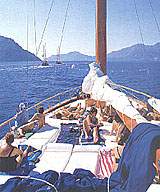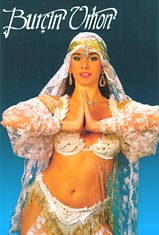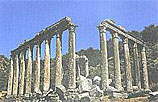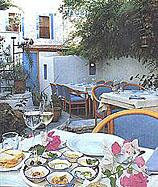|
Times are over when you had to search in Bodrum for a nice place to wine and dine. Here
are some places we tried ourself
 The Belly Dance The Belly Dance
The belly dance you will watch in Bodrum surely at least one evening, which is called " Turkish Night ".
Folklore, and in the end a belly dance is always in the program. Everything the hotels offer, isn't always the
*real* thing. Unfortunately in the last years more and more of the dancers have let it degenerate to a tourist
animation. Say it clearly, if it did not please you. Only this way can one stop it.
We would like to recommend two restaurants, the " Han " and "Kervansaray" here in Bodrum, which
still endeavor to present an authentic atmosphere.
And a real good and authentic belly-dance you can watch in our Bodrum-video.
Originally the belly dance, here called "Oriental Danse", was a fertility ritual, it had its exact meaning
in the religious rituals and ceremonies, today Oriental people see the dance as a high point to a social event,
and pay the dancer relatively highly. There are different styles and rhythmics. As various as the dance is, is
its music. It must be felt, it is in the heart, flowing into the whole body and expressind itself - all dances
contain rhytmic movements, copying the moment of birth or the sex act. In pre-Christian time the dance was religion
and the religion also referred the sexuality - erotica and sex were not like today separated from each other
.
Turkish Music
 Turkish classical music Turkish classical music
is based on 24 musical intervals, double the Western 12-note scale, so Turkish music simply has more sounds.
The main instruments essential in Turkish music are the ud and saz, tambur, kemençe, ney and kanun.  These instruments
generally accompany the human voice. These instruments
generally accompany the human voice.
In many respects, the development of Turkish music parallels that of music in the West. The style originally derived
from folk music, in this case that of central Asia. Music is also an important part of some religious sects, and
the Mevlevi (dervish order). The 13th century brought with it the consolidation of Turkish music into a classical
form and with the establishment of a sophisticated palace culture, music became a part of secular Iife, patronised
by the sultans.
The Ud
The ud, an instrument whose origins can be traced to antiquity, is the most widespread of Eastern instruments and
the ancestor of the European lute, which entered Europe from Moorish Spain and took its name from the Arabic al'ud.
With its deep pear-shaped body, thick, short neck and angled head, the Turkish ud is very like those found in Middle
Eastern countries. The medieval ud had frets and five strings. The frets have since disappeared and the modern
ud has eleven or twelve strings grouped in pairs. The top six strings are made of nylon and the others of metal.
The Tambur
The most important instrument in Turkish classical music is the tambur, a form of long-necked lute with a body
shaped like a half gourd. With a status equal to that held by the piano in Western music, the tambur's fingerboard
is the reference guide to tonal intervals in Turkish music.
The instrument is strung with seven or eight strings, usually plucked, although a bow can also be used to play
it. The tambur's long slender neck, sensitive to temperature and humidity, is made from well-seasoned wood.
The Kanun
the origins of the kanun, a plucked, zither-like instrument are vague. Similar instrument are found in ancient
Egypt and Samaria. Today, the kanun has 72 or 75 nylon strings which stretch across a shallow sound box, held on
the musician's lap. Tuned in groups of three, the strings give 24-25 notes. The various intermediate notes of the
Turkish scale are produced by the mandal board. Until the invention of the mandal board in the nineteenth century,
a player had to place his thumb on a string at the same time as he struck it with the plectrum.
The Kemençe
Taking its name from the Farsi for "little violin," the kemence is closely related to violins used in
Turkish folk music. The kemence has four strings and is held upright on the left leg with the bow drawn across
it like a cello. It is one of the most technically demanding of instruments. The musician raises the pitch of the
strings not by pressing down on them with his fingers, but by touching them lightly from the side with his fingernails.
The ney
Because of its rich harmonies and tonal range, the ney has been called the "most perfect wind instrument".
Its history goes back at least 2,000 years and it probably descends from a Samarian instrument called the na.
Made from a single, hollow-stemmed, woody reed, the ney has seven holes - six in the front, one at the back - and
is fitted with a mouthpiece of horn, ebony or ivory.
The ney is essential in religious music and has assumed an almost sacred status in the rituals of the Mevlevi where
its haunting melancholy tone has come to syrnbolize the mystic's yearning to return to God.
Camel fight
In the mild winter on the Aegean coast you can watch camel fights. This is a bloodless sport, it is a contest of
strength to see which camel can hold his opponent down the longest. Brilliant shots in the Bodrum-video
This process can take hours therefore the handlers intervene and pull them apart
Hamam, that’s the word for the Turkish bath - surely an unforgettable part of your holiday and the massage
is the best part. On the marble slab the guest will receive a pummeling from head to toe. After that you can relax
with a Çay (Turkish tea) and you feel reborn
TURKISH TRADITIONS
FOLK TRADITIONS
Folkmusic
The lively Turkish folkmusic, which originated on the steppes of Asia, is in complete contrast to the refined Turkish
classical music of the Ottoman court. Until recently, folkmusic was not written down, and the traditions have been
kept alive by the "asiklar" (troubadours). Distinct from folkmusic is Ottoman military music, now performed
by the "mehter takimi" (Janissary Band or Ottoman Army Band) in Istanbul, which originated in Central
Asia, and is played with kettle drums, clarinets, cymbals, and bells. The mystical music of the Whirling Dervishes
("Mevleviler") is dominated by the haunting sound of the reed pipe or "ney", and can be heard
in Konya during the Mevlana Festival in December.
Folkdances
Each region in Turkey has its own special folkdance and costume, and the best known of these are listed below:
a) "Horon" - This Black Sea dance is performed by men only, dressed in black with silver trimmings.
The dancers link arms and quiver to the vibrations of the "kemence" (a primitive kind of violin).
b) "Kasik Oyunu" - The Spoon Dance is performed from Konya to Silifke and consists of gaily dressed
male and female dancers '”clicking” out the dance rhythm with a pair of wooden spoons in each hand.
c) "Kilic Kalkan" - The Sword and Shield Dance of Bursa represents the Ottoman conquest of the
city. It is performed by men only, dressed in early Ottoman battle dress who dance to the sound of clashing swords
and shields, without music.
d) "Zeybek" - In this Aegean dance, colorfully dressed male dancers, called "efe," symbolize
courage and heroism.
Folk Heroes
a) Nasrettin Hoca - A 13th-century humorist and sage from Aksehir. His witticisms are known throughout Turkey
and are often used to make a point.
b) Karagöz - Another jester, said to have lived in Bursa in the 14th century and now immortalized as a shadow
puppet. Karagoz is a rough man of the people, who uses his ribald wit to get the better of his pompous friend,
Hacivat. The puppets are made from gaily painted, translucent animal skin and safe projected onto a white screen.
c) Yunus Emre - The 13th-century philosopher-poet is one of Turkey's national treasures. His basic themes
were universal love, friendship, brotherhood and divine justice. His simple and pure writing brings out a deep
meaning for his readers and although he lived over 700 years ago, his work is still timely and thought provoking.
d) Köroglu - A 15th-century folk poet, K6roglu was a role model for his contemporaries and a hero of
his time. His adventures have been recounted for centuries with prestige and vigor and perhaps now with more interest
than ever. Koroglu was one of the first people to pioneer the ideal of unconditional help for the poor and down-trodden.
He was also a great champion against the confines of government control and harassment.
Traditional sports
a) Yagli Güres" Greasy Wrestling" is the Turkish national sport and every year, in July,
wrestling championships are held in Kirkpinar, outside Edime. The contest is made more difficult by the fact that
the wrestlers smear themselves with oil.
b) Cilrit Oyunu - The "javelin game" of daredevil horsemanship is a sport where wooden javelins
are thrown at horsemen of opposing teams to gain points. The game is played mainly in Eastern Turkey. Also, in
Selcuk, in the Aegean Region you can watch camel fights (in January), but if for some reason, weather does not
permit, don't despair, camel fights are held in many small towns throughout the springtime. At Artvin Kafkasor,
a different type of bullfight is held (in June).
POPULAR CUSTOMS
Hospitality: Hospitality is one of the cornerstones of the Turkish way of life. Following Koranic tenets and naturally
friendly instincts, the Turk is a most gracious and generous host. Even the poorest peasant feels bound to honor
his guest ("misafir") in the best possible manner. Hospitality is taken to such lengths that a foreigner
often feels he is suffering from an overdose of it after being plied with food and drinks for hours and being unable
to refuse anything, lest he hurt his host's feelings. In addition to ensuring a guest's material well-being, the
Turk makes every effort to converse, no matter what linguistic barriers might exist. While most middle-class urban-dwelling
Turks speak at least one European language, even the uneducated bravely struggle to make themselves understood,
with remarkable success.
Turkish coffee houses: Even the smallest Turkish village has its coffee-house or "kahvehane", where men
can talk, sip coffee, and play the national game of backgammon ("tavla"). In Istanbul especially, men
can still be seen smoking their hubble bubble pipes ("nargile") in these coffee houses. Turkish baths:
Owing to the emphasis placed on cleanliness in Turkish society, there have been public bath-houses ('hamam")
in Turkey since medieval times. There are separate baths for men and women, or, when there is only one bath house
in the town, different days or times of day are allocated for men and women. After entering the "hamam"
and leaving one's clothes in a cubicle, one proceeds, wrapped in a towel ("pestemal") to the "gobek
tasi", a large heated stone where one perspires and is rubbed down by a bath attendant. If the heat proves
too much, one can retire to a cooler room for a while. This method of bathing is most refreshing and many of the
old marble baths are very interesting, architecturally.
Turkish handicrafts have formed a rich mosaic by merging the cultural heritage of various civilizations dating
back to thousands of years in Anatolia, with its own values.
It's possible to divide Turkish handicrafts as follows: Carpet-rug manufacturing, rug weaving, kerchief painting,
pottery, porcelain manufacturing, embroidery, needle-work, leather work, musical instrument manufacturing, stone-work,
jewelry and gemstone, copper- smith, basket making, packsaddle making, metal-work, felt making, knit-work, wood-
work, glassware, etc.
The raw materials of weavings are wool, mohair, cotton, animal hair, hemp and silk.
Weavings are fabric, knitting, upholstery, carpet, kilim, zili, cicim, felt and surcingles which are made of all
kinds of raw-materials that can be transformed into thread with spinning technique or any other techniques and
which are obtained by way of weaving, knitting or
only by attaching fibbers to each other in different methods.
Weaving is a traditional Anatolian handicraft which has been produced since ancient times and has been a source
of life in many regions. Jewelry is also remarkable.
The art of jewelry gained importance with the growth of the Ottoman Empire. Objects used in preparing and drinking
Turkish coffee were often made of copper and bronze. Today, the traditional art of metal work is surviving widely
in the production of copper kitchen utensils.
Handicrafts produced by using metals other than copper, like bronze, gold and silver are still alive today with
their high quality and various designs.
Wood working was developed during the Seljukian period in Anatolia and reached a quality unique to itself. Wooden
works of the Ottoman period are mostly architectural elements like pulpits, doors of mosques, cup- board doors
which are superior in craftsman-ship. Objects of daily use like small tables, writing equipments, chests, spoons,
drawers, thrones, reading-stands, Koran cases and in architectural elements like window, cup- board, joist, console,
column, capital, ceiling, pulpit, niche and sarcophagus. Materials used in wood working are mostly walnut, apple,
pear, ebony and rose trees. Another branch of art which has developed in connection with architecture is the art
of ceramic. Tile making was brought to Anatolia by the Seljukian artists. The new ceramic styles which emerged
in Iznik, Kutahya and Canakkale during the 15th and 17th centuries respectively and known by the names of their
region, with their specific style, characteristic of color, pattern and form, brought new interpretations to the
art of ceramic and tiles during the Ottoman period.
Hospitality
For Turkish people this is second nature and is certainly one of the highlights of Turkish travel. As a rule there
is no language barriers as you’ll find out when you are constantly asked by the locals such questions as, are you
married, how many children do you have and what Turkish football team do you support. (Choose Galatasaray, Besiktas
or Fehnerbahce.)
If you are invited to a Turkish home it is customary to remove your shoes before you enter. As a guest you will
be offered everything, where possible do not refuse as this can be taken as an insult.
If the conversation touches such subjects as politics, military activities or religion reserve comment.

|

|
|

|
|

|
|
Bodrum is the ideal starting point for the famous
 Blue Cruise Blue Cruise

|
|

|
|

|
|
 In ancient times - open sea, today a lake, the Bafa Gölü In ancient times - open sea, today a lake, the Bafa Gölü

|
|

|
|
 not far from Bafa lake, Euromos, another hidden gem not far from Bafa lake, Euromos, another hidden gem
|
|

|
|
|
Free Downloads

|
|
|

|
|

Send a Bodrum Postcard
|
|

|
|

|
|

|
|

|
|

Epsilon - in a romantic garden.

|
|
|
|

|
|
 the castle of St. Peter is a landmark
from all points of view the castle of St. Peter is a landmark
from all points of view
|
|

|
|

|
|